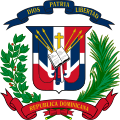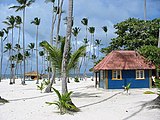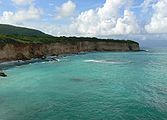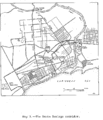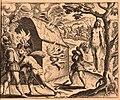Portal:Dominican Republic
Introduction
The Dominican Republic is a North American country on the island of Hispaniola in the Greater Antilles archipelago of the Caribbean Sea, bordered by the Atlantic Ocean to the north. It occupies the eastern five-eighths of the island, which it shares with Haiti, making Hispaniola one of only two Caribbean islands, along with Saint Martin, that is shared by two sovereign states. It is the second-largest nation in the Antilles by area (after Cuba) at 48,671 square kilometers (18,792 sq mi), and second-largest by population, with approximately 11.4 million people in 2024, of whom approximately 3.6 million live in the metropolitan area of Santo Domingo, the capital city. The Dominican Republic has the largest economy in the Caribbean region and the seventh-largest in Latin America. Over the last 25 years, the Dominican Republic has had the fastest-growing economy in the Western Hemisphere – with an average real GDP growth rate of 5.3% between 1992 and 2018. GDP growth in 2014 and 2015 reached 7.3 and 7.0%, respectively, the highest in the Western Hemisphere. Recent growth has been driven by construction, manufacturing, tourism, and mining. The country is the site of the third largest (in terms of production) gold mine in the world, the Pueblo Viejo mine. The Dominican Republic is the most visited destination in the Caribbean. The year-round golf courses and resorts are major attractions. A geographically diverse nation, the Dominican Republic is home to both the Caribbean's tallest mountain peak, Pico Duarte, and the Caribbean's largest lake and lowest point, Lake Enriquillo. The island has an average temperature of 26 °C (78.8 °F) and great climatic and biological diversity. The country is also the site of the first cathedral, castle, monastery, and fortress built in the Americas, located in Santo Domingo's Colonial Zone, a World Heritage Site. (Full article...) Selected article - Puerto Plata, officially known as San Felipe de Puerto Plata; (French: Port-de-Plate) is a major coastal city in the Dominican Republic, and capital of the province of Puerto Plata. The city is a major trading port. Puerto Plata has resorts such as Playa Dorada and Costa Dorada, which are located east of the city proper. There are 100,000 hotel beds in the city. The first aerial tramway of the Caribbean is located in Puerto Plata, in which visitors can ride up to the Pico Isabel de Torres, a 793-meter (2600-foot) high mountain within the city. The city’s history dates back to the early 16th century, when Spanish colonists founded a small colonial settlement in the region. During the first decades of the existence of the Captaincy General of Santo Domingo, the settlement was considered the main commercial and maritime port of the island. In 1605, it was depopulated and destroyed by order of Philip III of Spain to counter raids by English privateers and pirates; a hundred years later, the city was repopulated with farmers from the Canary Islands. From 1822 to 1844 the city was under Haitian control. From 1844 on began the period of the republic, in which the city began to recover its maritime and commercial boom. Beginning in 1865, the current Puerto Plata began to be built. This explains the Victorian style of much of its current architecture. By the end of the 19th century, Puerto Plata had become important for its cultural, social, maritime, and economic development. (Full article...)General images -The following are images from various Dominican Republic-related articles on Wikipedia.
Selected picture -Coral reef and school of yellow jack fish at Aquarium Reef, Catalina Island
Selected biography -Juan Luis Guerra Seijas (born 7 June 1957) is a Dominican musician, singer, composer, and record producer. He has sold 15 million records worldwide, making him one of the best-selling Latin music artists. Throughout his career, he has won numerous awards including 24 Latin Grammy Awards, three Grammy Awards, and one Latin Billboard Music Award. He won 3 Latin Grammy Awards in 2010, including Album of the Year. In 2012, he won the Latin Grammy Award for Producer of the Year. Guerra is one of the most internationally recognized Latin artists of recent decades. His popular style of merengue and Latin fusion has garnered him considerable success throughout Latin America. He is also credited for popularizing bachata music on a global level and is often associated with the genre, although his distinct style of bachata features a more traditional bolero rhythm and aesthetic mixed with bossa-nova influenced melodies and harmony in some of his songs. He does not limit himself to one style of music, instead, his music incorporates a wide arrange of diverse rhythms such as merengue, bachata, bolero, balada, fusion, salsa, cumbia, mambo, cha-cha-cha, pop, rock and roll, reggae, classical, R&B, folk, blues, jazz, funk, soul, rock, hip-hop/rap, son cubano, and religious, amongst many others. "Ojalá Que Llueva Café" ("I Wish That It Rains Coffee") is one of his most critically acclaimed pieces. (Full article...)Related portalsWikiProjects
Things to do
Associated WikimediaThe following Wikimedia Foundation sister projects provide more on this subject:
SourcesDiscover Wikipedia using portals | |||||||||||||||||||||||||
